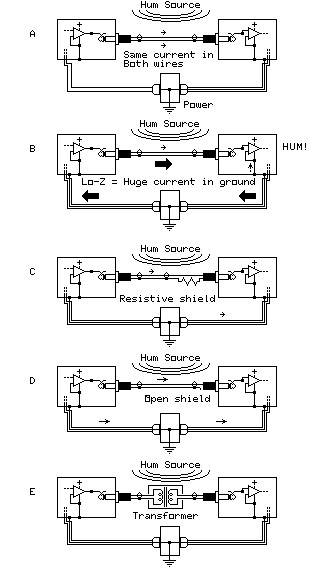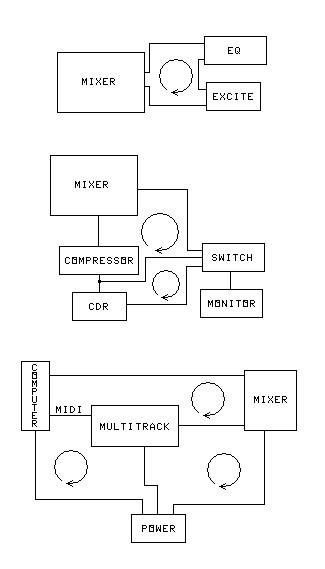What is a ground loop?
A ground loop is a complete circuit of low-impedance grounding conductors which has no load to slow down current flow. It acts as a loop antenna, which picks up power line hum and other electromagnetic noise, including radio signals.
How does a ground loop pick up the noise?
The source of electromagnetic waves induces a current in the ground loop through electromagnetic induction. Because the loop is a circuit of low-impedance conductors, a very large current can be induced from a very small electromagnetic field.
Why does the ground loop cause noise in the signal lines, when the current is flowing in the ground lines?
Actually, it doesn't. The current flowing in the ground lines makes the ground potential at one or more devices CHANGE, relative to the ground potential at other devices. The signal going from one of these devices to another is then seen by the receiving device as having this ground differential superimposed upon it.
So the ground loop really tricks the device into thinking the hum is on the signal line?
That's exactly right. Since the ground is supposed to be the reference, the device compares the signal line to the ground line to get the signal. It sees hum voltages between the signal line and the ground line, so it thinks it's part of the signal.
Why don't other cables pick up the hum?
The currents induced in both the shield and the center conductor are identical, as long as a ground loop does not exist. In illustration A, the hum appears on both the signal line and the shield, so the device does NOT see it as part of the signal.
Why is it that sometimes I have ground loops, and sometimes I don't?
It depends on EVERY grounding connection to each device, including the power line safety grounds. Look in illustration A: The signal line connects the ground between the two devices, but only the receiving device has a safety ground in the power cord. The sending device is double-insulated instead. In illustration B, both devices have safety grounds in their power cords. The shield of the signal cable, plus the two power cords, complete the ground loop.
So should I remove the safety ground, or use a 3-prong to 2-prong adaptor, to break the safety ground?
NO! NEVER interrupt the safety ground of a device that was designed to have one.
You are risking your own life, or the lives of others. All it takes is a coke spilled into a device, and somebody is toast! It is much better to deal with ground loops in the signal lines.
So how DO you get rid of ground loops?
There are several methods:
- The quickest method is to cut the shield of one signal cable in the loop, at the load end. This is
shown in illustration D. This forces the ground return current to flow through the other half of the
former ground loop. This does have a disadvantage, as the cable can no longer be used for anything else
except to break ground loops. Be sure to label it as such.
There is also another serious problem. Disconnecting any of the other cables that comprised the former ground loop will now produce a very LOUD hum, as one device becomes totally ungrounded. This can blow out speakers or ears.
- You could also make up a set of short ground loop breaker cables, with the shield disconnected at one end. Put one male and one female connector on each cable, and insert it into the cable run every place you find a ground loop. But beware, because disconnecting other cables can still produce the very loud hum.
- A better trick is to put a 10 ohm resistor into the ground leg, instead of just cutting the shield,
as in illustration C. This keeps the loud hum from happening if one of the other cables in the former
ground loop is disconnected. The resistor can also be put in the short ground loop breaker cable for
the same purpose.
The resistor works by loading down the ground loop current. The huge currents cannot flow, and so the hum is not induced. But if more than one cable in the loop has a resistor, then a weak hum can occur due to a lack of solid grounding.
- Grouping the ground loop cables into a snake prevents the hum, even though the ground loop still exists. This is because gathering both legs of the loop into one cable causes both legs to have equal but opposite currents induced. The currents cancel each other out.
- Likewise, you can bundle cables in the ground loop together with cable ties, provided they are the same length.
- The best way to break a ground loop is to use a ground loop isolation transformer, as in illustration E. This passes signal, and keeps everything grounded, but will not pass ground loop currents at all. Disconnecting other cables also produces no hum.
How can I recognize the ground loop?
Look for any place where signal cables form a circle, or where signal cables and power line safety grounds form a circle. See second panel at right.
Can other cables also form ground loops?
Yes. Computer and digital audio cables can become part of ground loops. Sometimes the computer monitor can form a path. MIDI is usually immune from ground loops because the coupling is optoisolated. But if the MIDI device takes its power from the MIDI sending device, the ground isolation is lost.
I have also seen ground loops in permanent wiring cause a digital stage lighting control system to go nuts. And all of those ground connections were required by the electrical code to be there, so there was no cure!
Links:
- More on grounding and noise:
Banish noise from your studio. - The difference between an insert and an effects loop.
The two kinds of effects. - My mixing page:
Mixing your own sound. - My home page
Home
"Look for any place where signal cables form a circle, or where signal cables and power line safety grounds form a circle."
"The best way to break a ground loop is to use a ground loop isolation transformer."
Ground Loop causes and cures:

A - No ground loop exists, because one device is double-insulated.
B - Ground loop through power safety grounds causes hum.
C - Breaking ground loop with 10-Ohm resistor.
D - Breaking shield to get rid of ground loop.
E - Ground loop isolation transformer.
Ground Loop Situations:

Top: Ground loops often show up in effects loops and insert loops.
Middle: Multiple monitor selection arrangements often produce ground loops. Here, more than one ground loop is formed.
Bottom: Ground loops can be formed through the computer too.